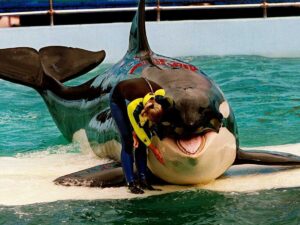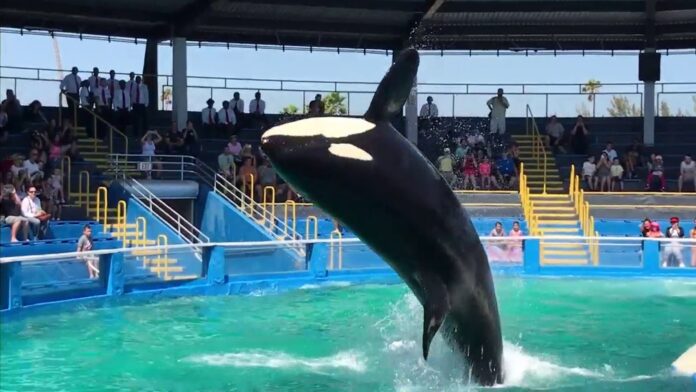In a groundbreaking decision, the Miami Seaquarium announced on Thursday that they would release Lolita, a 56-year-old killer whale, from captivity and return her to her native Pacific Northwest waters. This milestone comes after decades of tireless activism by animal rights groups, who have long argued that Lolita deserves to live out her life in the wild.
The Fight for Freedom
As one of the oldest orcas in captivity, Lolita’s plight has been at the center of a passionate campaign led by Friends of Toki (Lolita) for many years. Pritam Singh, the group’s leader, spoke about the unexpected support that brought this dream to the cusp of reality. He said, “The angels showed up and made this happen.”
A Difficult Past and an Uncertain Future
Despite the joyful news, Lolita’s journey is far from over. Over the years, she has faced multiple health scares, including a recent infection that led her to stop eating. Additionally, there are significant logistical and financial challenges involved in moving a 5,000-pound whale across the country and teaching her to hunt again.
Lolita’s past also bears witness to the hardships she has endured. In 1970, she and several other whales were violently captured from a pod in Puget Sound near Seattle, resulting in the deaths of four baby whales and an adult. A decade later, at the aquarium, she lost her mate, Hugo, to a brain aneurysm he suffered after repeatedly ramming his head into his tank.

A Generous Offer and a Glimmer of Hope
Jim Irsay, owner of the Indianapolis Colts, has stepped up to fund Lolita’s transfer, estimating that it could cost more than $20 million. Irsay, a lifelong whale enthusiast, expressed confidence in Lolita’s determination to survive and adapt to her new life.
The first step in Lolita’s journey will involve transporting her and her two dolphin companions to the Pacific Northwest. After acclimating and learning to hunt, it is hoped that she will be healthy enough to join a pod that includes an 89-year-old whale believed to be her mother.
A Historic Collaboration and a Personal Connection
The agreement between Friends of Toki (Lolita) and The Dolphin Company marks a historic collaboration, with Miami-Dade Mayor Daniella Levine Cava hailing the decision as a great day for the city. The Dolphin Company’s CEO, Eduardo Albor, recalled his personal commitment to freeing Lolita after a visit to the park with his daughter, who could not bear to see the whale confined in a small space.

Lessons from Keiko’s Story
As the plan to release Lolita unfolds, experts and activists look to the case of Keiko, the killer whale who inspired and starred in the 1993 film “Free Willy.” Keiko became the first orca to be successfully returned to the wild in 2002, more than 20 years after being captured off the coast of Iceland. Though he eventually passed away due to pneumonia in 2007, his five years in the wild serve as a model for Lolita’s potential transition.
A Complex Operation with Careful Planning
The relocation process for Lolita involves a series of carefully planned steps. First, she and her two dolphin roommates will be transported by a specialized plane to a temporary habitat in the Pacific Northwest. Once there, Lolita will undergo a period of acclimation and training to help her learn crucial survival skills, such as hunting.
Monitoring Progress and Adapting the Plan
Throughout the process, experts will closely monitor Lolita’s health and progress to determine the best course of action. If all goes well and she proves healthy and capable, the final stage will be to release her into the wild, where she may have the chance to join her family pod.
Inspiring Change and Creating a Ripple Effect
Lolita’s story has garnered widespread attention, sparking a broader conversation about the ethical treatment of captive animals. As the plan to release her unfolds, it is likely to inspire renewed efforts to improve conditions for other animals in similar situations. The historic collaboration between animal rights groups, private companies, and individuals in Lolita’s case could serve as a blueprint for future campaigns.
A Legacy of Hope and Resilience
As the world watches the unfolding of Lolita’s remarkable journey from captivity to freedom, her story serves as a powerful reminder of the resilience of the animal spirit and the transformative power of collaboration. Her legacy will undoubtedly leave a lasting impact on the fight for animal rights and inspire a new generation of activists to continue advocating for the welfare of all creatures, both in captivity and in the wild.
The Road Ahead and a Final Thought
While the road ahead for Lolita remains fraught with challenges, the extraordinary efforts of those involved in her release offer hope that she will soon be able to embrace a life of freedom in her natural habitat. This monumental undertaking serves as a testament to the power of compassion, determination, and collaboration in overcoming seemingly insurmountable obstacles. Lolita’s journey from captivity to freedom is not only a victory for her but also a beacon of hope for countless other animals and a rallying point for those who fight for their rights and well-being.


